![]() August 1996
August 1996
This month's features in our
'sea-side holiday' issue :
August is the traditional holiday month for many. Whether you're going abroad or just visiting a different area of your own country, there is likely to be plenty of nature around you that is unfamiliar. So don't forget to pack a 10X hand lens to explore the miniature aspects of nature when you're out and about.
This month, in between the sunbathing, we have a stroll around the beach, explore the rock pools and examine fish off-loaded at the harbour.
Please read the important notes on collecting.
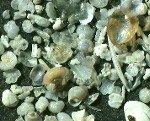 While you're on the
beach enjoying the sun, there's a potential source of microscopic
interest all around you .... the sand, and beaches in general.
Keep an eye out for shells, which can have interesting colours
and patterns such as the shell (diameter 14mm) at the top of the
page.
While you're on the
beach enjoying the sun, there's a potential source of microscopic
interest all around you .... the sand, and beaches in general.
Keep an eye out for shells, which can have interesting colours
and patterns such as the shell (diameter 14mm) at the top of the
page.
Sponge spicules
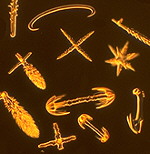 The needle-shaped object in
the sand shown above is a sponge spicule, and are worth looking
for in sand samples. They are delicate glass-like forms that
occur in a wide variety of shapes and sizes. A selection of them
obtained from a well-known site in New Zealand called Oamaru is
shown on the right. They are part of an arrangement on an old
microscope slide. You will be lucky to find such a variety as
this, but the sand sample from Eire above had a number of
spicules similar to the cross-shaped spicule in the image.
The needle-shaped object in
the sand shown above is a sponge spicule, and are worth looking
for in sand samples. They are delicate glass-like forms that
occur in a wide variety of shapes and sizes. A selection of them
obtained from a well-known site in New Zealand called Oamaru is
shown on the right. They are part of an arrangement on an old
microscope slide. You will be lucky to find such a variety as
this, but the sand sample from Eire above had a number of
spicules similar to the cross-shaped spicule in the image.
Seaweed
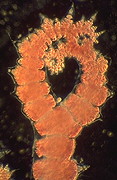 Rock pools will
have a wealth of interesting subjects in. The smaller red
seaweeds such as Ceramium are very attractive under a
lens and a section of the tips of the fronds of this seaweed is
shown left under dark-ground illumination using a compound
microscope. Seaweeds are algae, and occur in an amazing variety
of sizes and forms. Algae span seven orders of magnitude in size
from tiny flagellates less than 1 micrometre to giant kelp, a
type of seaweed, which can reach a length of 60m in some areas of
the world.
Rock pools will
have a wealth of interesting subjects in. The smaller red
seaweeds such as Ceramium are very attractive under a
lens and a section of the tips of the fronds of this seaweed is
shown left under dark-ground illumination using a compound
microscope. Seaweeds are algae, and occur in an amazing variety
of sizes and forms. Algae span seven orders of magnitude in size
from tiny flagellates less than 1 micrometre to giant kelp, a
type of seaweed, which can reach a length of 60m in some areas of
the world.
Fish scales
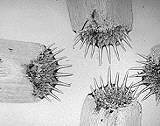 If you are wandering
along a harbour where fisherman maybe off-loading their catch,
try and obtain a few samples of fish scales. Different fish
species have characteristic scales, and after cleaning and drying
are interesting to view under a stereo microscope, as well as the
compound microscope using dark-ground illumination or cross
polarisers. The fish scales shown right are from the sole, a
flatfish (family Soleidae).
If you are wandering
along a harbour where fisherman maybe off-loading their catch,
try and obtain a few samples of fish scales. Different fish
species have characteristic scales, and after cleaning and drying
are interesting to view under a stereo microscope, as well as the
compound microscope using dark-ground illumination or cross
polarisers. The fish scales shown right are from the sole, a
flatfish (family Soleidae).
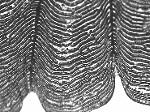 The fish scale on the left is
from the cod (family Gadidae) and is typically 10mm across. This
scale does not possess the spines seen in that of the sole above.
Fish scales provide protection from the environment and from
predators and are formed from bone from the deeper, or dermal,
skin layer. There are a variety of types of fish scale. True
teeth, for example, are thought to have developed from a type of
scale called placoid scales. The typical overlapping fish scale
of the cycloid type are large, thin or oval in shape and exhibit
growth rings along their free edges. Ctenoid scales resemble
cycloid scales but have comb-like teeth on their overlapping
edge.
The fish scale on the left is
from the cod (family Gadidae) and is typically 10mm across. This
scale does not possess the spines seen in that of the sole above.
Fish scales provide protection from the environment and from
predators and are formed from bone from the deeper, or dermal,
skin layer. There are a variety of types of fish scale. True
teeth, for example, are thought to have developed from a type of
scale called placoid scales. The typical overlapping fish scale
of the cycloid type are large, thin or oval in shape and exhibit
growth rings along their free edges. Ctenoid scales resemble
cycloid scales but have comb-like teeth on their overlapping
edge.
The larger encyclopaedias such as Encyclopaedia Britannica should have good descriptions of general seaside life and features, such as sand and beach formation, seaweed, fishes and their scales etc.
A good illustrated field-guide to the plants and animals of seashores in Europe is 'Seashores of Britain and Europe' by A Campbell. Hamlyn, London, 1994. ISBN 0 600 58376 7.
Techniques for preparing slides of foraminifera obtained from
chalk etc are often found in the microscopy club magazines.
For example:
Extracting Fossil Foraminifera from Chalk by
Andrew Syred, Balsam Post, 1993, no. 21, p25-27. ISSN 0961-043X.
Fossil Forams by Fred Loxton, Balsam Post, 1994,
no. 22, p31-32.
Balsam Post is the quarterly newsletter of the Postal
Microscopical Society, UK.
The close-up of the shell and sand were taken with a CCD camera with a 50mm SLR camera lens and extension tubes attached. Camera images were transferred to the PC using a Creative Video Spigot capture card. Image manipulation using Photostyler v2.0 software.
The sponge spicules, fish scales (sole) and seaweed are from
prepared microscope slides circulated by the Postal Microscopical
Society (PMS) UK, and are credited as follows.
Sponge spicules (a selection from Oamaru) - submitted by R Darby,
prepared by R Suter.
Fish scales (sole) - from PMS collection. Prepared by J T Norman
in the 19th Century.
Seaweed (Ceramium echinotum) from S. Devon coast, UK -
Submitted and prepared by B Darnton.
The author Dave Walker
is a UK based amateur naturalist keen to encourage people to
explore nature in close-up.